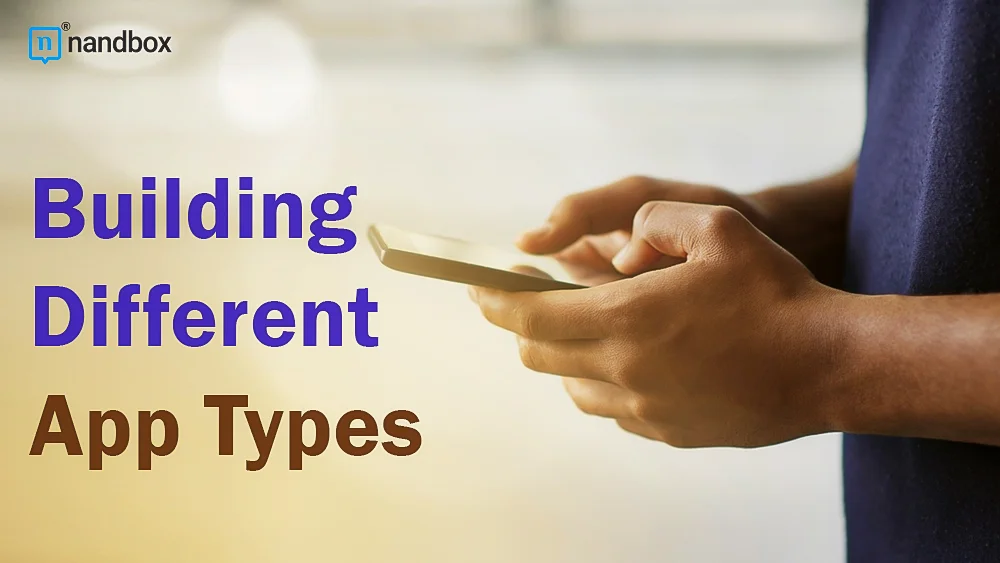Applications nowadays have become integral for everyone’s usage. Apps make our lives easier. It is important that we know how to efficiently make them a part of our daily lives. Additionally, it is important to leverage the power they grant us with. Moreover, apps offer solutions for almost every aspect of any business. One that wishes to have more exposure and visibility in today’s busy app market. Nowadays, anyone who wishes to expose their business thinks of having an app. That is, in order to successfully reach what they aim for. But with so many options and industries, which app should you build? Building different app types is something that a lot of people consider; however, building one specifically for your business or industry is what you should focus on. That is why this article will delve into the aspects of building different app types. Moreover, we will delve into understanding which one works best for you. As an individual or a business owner in general.
Understanding the core features of the app that you want to build is the very first step that will put you on the right track. Moreover, you should also understand the benefits and challenges of various app categories in order to know more and narrow your options to make an informed decision. Dive deep with me in this article to know the most popular app types and explore what makes them successful and how they can be developed efficiently. This guide is for you regardless of your goal, whether you’re building an app for simple interactions, simplifying tasks, or simply providing entertainment. Ready? Let’s go!
Social Media Apps: Connecting People and Ideas
With social media shifting and changing life as we know it, it has fundamentally changed how people communicate, share, interact with, and consume information. But again, with so many successful apps in the current market, what makes a social media app stand out from the rest of the crowd? Simply put, it all goes down to engagement. Take successful apps as your own reference to success. Apps like Facebook, Instagram, and TikTok thrive because they know who exactly they are targeting. They understand what their audience needs, and they offer it to them in order to increase their app interactions and engagement. Let me give you an example.
Instagram offers a visually driven design that caters to image and video sharing. Tell me honestly, how many hours per day do you spend sending reels to your friends, family, and people in your social circle? If you were to ask me that question, I would tell you that I do spend indeed an hour or more per day doing only that. Another great example is TikTok. Its addictive algorithm makes you spend a lot of hours on it and keep going back to it whenever you’re up to watching some entertaining short videos. One thing I love to surf on TikTok is song covers by random people. Building a social media app is all about implementing the right features for your audience.
How to Know the Right Features for Your Social Media App?
These features are ones that will leave people wanting more from your app and wanting to always go back to it. In order to implement those features, you have to check out what other apps that could be your potential competitors implement. This is a process that requires a thoughtful and strategic approach. One that will help you know how to create an efficient user profile, a personalized feed, and real-time interactions. Consider adding innovative elements like AR filters or audio-based rooms, similar to Snapchat and Clubhouse, to set your app apart.
Ever thought about how Snapchat has no equivalent? Because it targets specific people who love certain actions like sending snaps and streaks. Adding something that makes you unique, like nandbox’s Messenger’s feature of having 4 different profiles using the same authentication email, is something that will help you get noticed in an easier way by others who would wish to have your app just because of the little unique feature.
Building Different App Types: E-commerce Apps

E-commerce apps have revolutionized the retail industry. That is because it is bringing the convenience of shopping into the palms of users. But building an e-commerce app is not such an easy piece of cake process. As a matter of fact, it requires a deep understanding of customer behavior and a seamless user experience.
Successful apps like Amazon and eBay offer features such as personalized recommendations, secure payment systems, and real-time inventory updates. They implement these elements based on an extensive analysis of user behaviour. Ever access Amazon and see on the main page an item that you’ve previously viewed on a very seductive discount? That is because you may have viewed it more than once, and Amazon’s intelligent algorithm decided to help you by providing you with sellers who have that specific item on discount to encourage you to purchase that item. These elements, when implemented in the right way, help in encouraging users in completing purchases and always going back to the app for more purchases and interactions.
Another main thing that e-commerce apps should have is the fact that they should provide users with a joyful and easy shopping experience. In the 2019 COVID pandemic, a lot of people started opting for online shopping as a haven from having to mix with people in real-time mall shopping. And that is when a lot of apps thrived and prospered.
How Do e-Commerce Apps Leverage the Power of Certain Situations?
During the COVID-19 pandemic, e-commerce and shopping apps leveraged the power of bending bad situations to their side and started introducing services like safe delivery of every product through delivery couriers who adhered to wearing masks, disinfecting their shipment containers, and wearing protective disinfected gloves for gaining more trust and credibility… and more orders, of course. Moreover, mobile shopping apps are increasingly integrating immersive technologies like AR to let users “try” products virtually, whether it’s furniture in their living room or makeup on their face. The goal is to make shopping not only convenient but also engaging, so users keep coming back for more.
Educational Apps: Learning Anytime, Anywhere
Educational apps have transformed how people learn. That is because they provide opportunities for growth that transcend traditional classrooms. From language-learning tools like Duolingo to academic platforms like Khan Academy. These are all apps that offer personalized educational experiences that cater to various audiences. But what does it take to create a successful educational app? First, understanding your target audience is crucial. Apps for children may include gamified learning elements, colourful designs, and interactive quizzes. That is, to make lessons fun and engaging and to attract a child’s attention easily.
On the other hand, apps for professionals often focus on delivering comprehensive courses, certifications, and progress tracking features. Flexibility is key here when it comes to building an educational app. That is because these apps allow users to learn at their own pace through downloadable materials and offline access. Accessibility also plays a major role, with features such as closed captions, text-to-speech functionality, and multi-language support broadening the reach of your app. When you prioritize both functionality and inclusivity, your educational app will cater to diverse learning needs in an effective manner.
Building Different App Types: Healthcare Apps
Healthcare apps are not just convenient tools. They can be life-saving resources when needed. From fitness trackers to telemedicine platforms, these apps empower users to take charge of their health. A well-designed healthcare app must prioritize user trust, given the sensitive nature of medical information. These apps have to have a top-notch level of security in order to protect their users’ information and keep it from getting leaked. Popular apps like MyFitnessPal or Fitbit focus on health and wellness. That is because they offer features like activity tracking and calorie monitoring.
Meanwhile, apps like Zocdoc simplify access to medical professionals. This allows users to book appointments with ease. When creating a healthcare app, features like secure data storage, HIPAA compliance, and user-friendly navigation are non-negotiable. They are considered must-have features that your app won’t be successful without. For example, integrating telehealth services can connect patients with doctors remotely, while AI-based tools can assist users in monitoring symptoms or managing chronic conditions. A healthcare app succeeds when it enhances user well-being while maintaining a strong foundation of trust and security.
In Conclusion
In a world driven by mobile-first experiences, the diversity of apps and the process of building different app types demonstrate the vast opportunities for developers and businesses. Whether you’re aiming to foster connections through a social media app, redefine convenience with a utility app, or revolutionize healthcare delivery, there’s a niche waiting to be filled. Each app type comes with its unique challenges and opportunities, but the common thread is the importance of user-centric design and functionality.
Understanding those challenges and untangling them will help you decide which app you should build and opt for that suits your industry best. If you’re ready to turn your app idea into reality, nandbox’s native no-code app builder can help you build robust, scalable apps. That is, without the need for any coding or programming expertise. With nandbox, you have the power to bring your vision to life efficiently and effectively.






